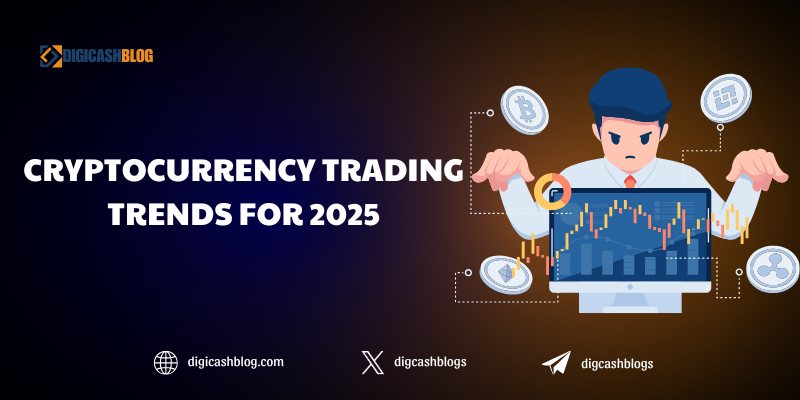The cryptocurrency market, valued at $2.66 trillion in 2025, is a dynamic arena where trading strategies evolve rapidly due to technological advancements, regulatory shifts, and macroeconomic factors. Cryptocurrency trading trends for 2025 reflect a maturing ecosystem, with institutional participation, AI-driven tools, and decentralized finance (DeFi) shaping how traders navigate volatility. This article explores the key trading trends, their drivers, and strategies for traders, offering insights for researchers and investors.
Cryptocurrency Trading Trends for 2025
Institutional Trading and ETF Dominance
Institutional investors are driving trading volumes, with Bitcoin and Ethereum spot ETFs managing over $36 billion in assets in Q1 2025. Major firms like BlackRock and Fidelity have fueled demand, with X posts noting Bitcoin ETF inflows outpacing spot prices. Predictions suggest altcoin ETFs, such as Solana and XRP, may launch by Q4 2025, diversifying trading opportunities. Institutional strategies focus on hedging with futures and options, reducing risk in volatile markets, as seen with Bitcoin’s 20% Q1 pullback due to U.S. tariffs.
AI-Powered Trading and Automation
AI integration is revolutionizing crypto trading, with algorithms optimizing strategies for DeFi and spot markets. Platforms like Bittensor enable AI-driven trading bots that analyze on-chain data and execute trades with minimal latency. In 2025, AI tokens, valued at over $40 billion, support automated market makers (AMMs) in DeFi, enhancing liquidity and reducing slippage. X posts highlight AI agents like Coinbase’s Based Agent transforming trading, offering predictive analytics and portfolio optimization. This trend empowers retail traders but raises concerns about over-reliance on automation.

Stablecoin-Driven Trading Strategies
Stablecoins, with daily settlement volumes projected to reach $300 billion, are central to trading strategies. Traders use USDT and USDC to hedge against volatility, especially in emerging markets like South America, where stablecoins dominate 61.8% of Argentina’s crypto volume. In 2025, stablecoin pairs on decentralized exchanges (DEXes) like Uniswap account for 20% of centralized exchange (CEX) spot volumes, offering low-cost, instant settlements. This trend facilitates high-frequency trading and arbitrage across chains.
Layer-2 and Cross-Chain Trading
Layer-2 solutions, such as Arbitrum and Polygon, are reshaping trading by reducing transaction costs to below $0.01, compared to Ethereum’s $10 peaks in 2023. Cross-chain dApps enable seamless trading across blockchains like Ethereum, Solana, and Binance Smart Chain, with Uniswap’s cross-chain swaps gaining traction. X posts note layer-2 fees rising to 25% of altcoin layer-1 fees, signaling increased trading activity. Traders leverage these platforms for low-cost, high-speed strategies, though scaling limits may cause fee spikes.
Memecoin and Social Media-Driven Trading
Memecoins like Dogecoin and FLOKI remain volatile trading assets, driven by social media sentiment on platforms like X. With 17% of investors eyeing Solana-based memecoins, community-driven pumps are common, as seen in FLOKI’s 2025 forecast of $0.000102-$0.000335. Traders use tools like LunarCrush to track sentiment, capitalizing on short-term price spikes. However, bot-driven posts, estimated at 15% of crypto tweets, pose risks of manipulation, requiring traders to verify signals with on-chain data.
Drivers of Trading Trends
Regulatory Clarity and Policy Shifts
Regulatory frameworks like the EU’s MiCA and the U.S. executive order on digital assets (January 2025) enhance trading confidence. The U.S. Strategic Bitcoin Reserve and stablecoin laws reduce compliance burdens, encouraging institutional trading. However, global tariff policies, as noted in Q1 2025, triggered a 4.2% Bitcoin drop, highlighting the need for adaptive strategies.
Technological Advancements
Blockchain scalability, driven by layer-2 solutions and Ethereum’s upgrades, supports high-frequency trading. AI and on-chain analytics from platforms like Glassnode provide real-time insights, enabling traders to exploit market inefficiencies. The rise of tokenized real-world assets (RWAs), with a $20 billion market cap, introduces new trading pairs, diversifying portfolios.
Market Sentiment and Volatility
The Crypto Fear and Greed Index, averaging 70 (Greed) in May 2025, signals bullish sentiment, though Q1’s “extreme fear” at 20 offered buying opportunities. Bitcoin’s volatility, now below 50% compared to 70% in 2020-2022, supports stable trading environments, but altcoins face sharper corrections, with up to 60% declines projected mid-2025.
Challenges in Crypto Trading
Despite reduced volatility, macroeconomic factors like U.S. tariffs and inflation fears drive price swings, as seen in Bitcoin’s drop from $108,786 in January to $80,200 in March 2025. Traders must use derivatives and stablecoins to hedge against such risks, balancing potential gains with market downturns.
Crypto crime, with $40.9 billion in illicit transactions in 2024, remains a challenge. Stablecoin freezes by issuers like Tether deter illicit activity, but traders face risks from hacks and scams. Secure wallets with biometric authentication and multi-party computation are critical for safe trading.
The influx of social media data complicates sentiment analysis, with bot accounts distorting trends. Traders must combine tools like Santiment with technical indicators like Bollinger Bands to filter noise and confirm signals, ensuring informed decisions.
Strategies for Traders
- Leveraging AI and Analytics
Traders should use AI-driven platforms and on-chain analytics from Glassnode or Dune Analytics to identify trends and optimize entries/exits. Monitoring whale activity via Whale Alert enhances decision-making, especially for altcoins.
- Diversifying with Stablecoins and ETFs
Incorporating stablecoin pairs and ETF-based strategies reduces risk. Trading on DEXes with low fees, like Arbitrum, maximizes returns, while ETF futures offer institutional-grade hedging.
- Combining Technical and Sentiment Analysis
Using indicators like moving averages and RSI alongside sentiment tools like the Fear and Greed Index helps traders navigate volatility. X trends and community sentiment can signal short-term opportunities, particularly for memecoins.

Cryptocurrency trading trends for 2025 indicate a shift toward institutional-driven, technology-enhanced strategies. Bitcoin is projected to reach $150,000-$185,000 by Q4, with DeFi TVL exceeding $200 billion. Stablecoins and layer-2 solutions will dominate trading volumes, while AI and cross-chain platforms expand opportunities. Regulatory clarity will sustain bullish sentiment, but traders must remain vigilant of macroeconomic risks and security threats to capitalize on this evolving market.
Cryptocurrency trading trends for 2025 highlight a maturing market driven by institutional adoption, AI automation, and stablecoin utility. Layer-2 solutions and social media-driven memecoins offer diverse opportunities, but volatility and security risks persist. By leveraging advanced analytics, diversifying strategies, and aligning with regulatory shifts, traders can navigate the dynamic crypto landscape, positioning themselves for success in a transformative year.
